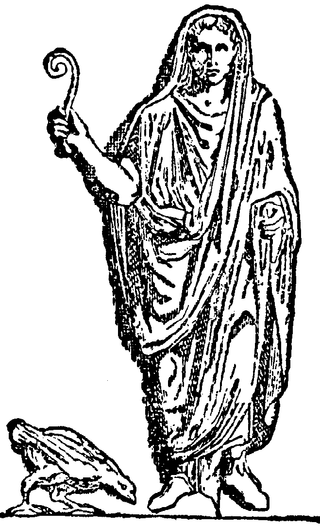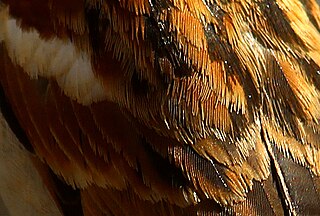
Poultry are domesticated birds kept by humans for the purpose of harvesting animal products such as meat, eggs or feathers. The practice of raising poultry is known as poultry farming. These birds are most typically members of the superorder Galloanserae (fowl), especially the order Galliformes. The term also includes waterfowls of the family Anatidae but does not include wild birds hunted for food known as game or quarry.

The chicken is a large and round short-winged bird, domesticated from the red junglefowl of Southeast Asia around 8,000 years ago. Most chickens are raised for food, providing meat and eggs; others are kept as pets or for cockfighting.

Guineafowl are birds of the family Numididae in the order Galliformes. They are endemic to Africa and rank among the oldest of the gallinaceous birds. Phylogenetically, they branched off from the core Galliformes after the Cracidae and before the Odontophoridae. An Eocene fossil lineage Telecrex has been associated with guineafowl; Telecrex inhabited Mongolia, and may have given rise to the oldest of the true phasianids, such as blood pheasants and eared pheasants, which evolved into high-altitude, montane-adapted species with the rise of the Tibetan Plateau. While modern guineafowl species are endemic to Africa, the helmeted guineafowl has been introduced as a domesticated bird widely elsewhere.

Augury was a Greco-Roman religion practice of observing the behavior of birds, to receive omens. When the individual, known as the augur, read these signs, it was referred to as "taking the auspices". "Auspices" means "looking at birds". Auspex, another word for augur, can be translated to "one who looks at birds". Depending upon the birds, the auspices from the gods could be favorable or unfavorable. Sometimes politically motivated augurs would fabricate unfavorable auspices in order to delay certain state functions, such as elections. Pliny the Elder attributes the invention of auspicy to Tiresias the seer of Thebes.

The spectral bat, also called the great false vampire bat, great spectral bat, American false vampire bat or Linnaeus's false vampire bat, is a large, carnivorous leaf-nosed bat found in Mexico, Central America, and South America. It is the only member of the genus Vampyrum; its closest living relative is the big-eared woolly bat. It is the largest bat species in the New World, as well as the largest carnivorous bat: its wingspan is 0.7–1.0 m (2.3–3.3 ft). It has a robust skull and teeth, with which it delivers a powerful bite to kill its prey. Birds are frequent prey items, though it may also consume rodents, insects, and other bats.

Ephraim Chambers was an English writer and encyclopaedist, who is primarily known for producing the Cyclopaedia, or an Universal Dictionary of Arts and Sciences. Chambers' Cyclopædia is known as the original source material for the French Encyclopédie that started off as a translation of Cyclopædia.

Plumage is a layer of feathers that covers a bird and the pattern, colour, and arrangement of those feathers. The pattern and colours of plumage differ between species and subspecies and may vary with age classes. Within species, there can be different colour morphs. The placement of feathers on a bird is not haphazard but rather emerges in organized, overlapping rows and groups, and these feather tracts are known by standardized names.

Conflation is the merging of two or more sets of information, texts, ideas, or opinions into one, often in error. Conflation is defined as 'fusing blending', but is often used colloquially as 'being equal to' - treating two similar but disparate concepts as the same. Merriam Webster suggested this shift in usage happened relatively recently, entering their dictionary in 1973.

Bagnio is a loan word into several languages. In English, French, and so on, it has developed varying meanings: typically a brothel, bath-house, or prison for slaves.

Chamois leather is a type of porous leather, traditionally the skin of the chamois, a type of European mountain goat, but today made almost exclusively from the flesh split of a sheepskin.

A nest box, also spelled nestbox, is a man-made enclosure provided for animals to nest in. Nest boxes are most frequently utilized for birds, in which case they are also called birdhouses or a birdbox/bird box, but some mammals such as bats may also use them. Placing nestboxes or roosting boxes may also be used to help maintain populations of particular species in an area.

The lesser horseshoe bat is a type of small European and North African insectivorous bat, related to its larger cousin, the greater horseshoe bat. As with all horseshoe bats, the species gets its name from its distinctive horseshoe-shaped noseleaf.

A culverin was initially an ancestor of the hand-held arquebus, but the term was later used to describe a type of medieval and Renaissance cannon. The word is derived from the antiquated "culuering" and the French "couleuvrine" From its origin as a hand-held weapon it was adapted for use as artillery by the French in the 15th century and for naval use by the English in the 16th century. The culverin as an artillery piece had a long smoothbore gun barrel with a relatively long range and flat trajectory, using solid round shot projectiles with high muzzle velocity.

Mosaic gold or bronze powder refers to tin(IV) sulfide as used as a pigment in bronzing and gilding wood and metal work. It is obtained as a yellow scaly crystalline powder. The alchemists referred to it as aurum musivum, or aurum mosaicum. The term mosaic gold has also been used to refer to ormolu and to cut shapes of gold leaf, some darkened for contrast, arranged as a mosaic. The term bronze powder may also refer to powdered bronze alloy.
Azone is a term in mythology anciently applied to gods and goddesses that were not the private divinities of any particular country or people. Azones were acknowledged as deities in every country, and worshipped in every nation. The word is etymologically derived from Greek for "without" and "country". The azones were to a degree above the visible and sensible deities, which were called zonei, who inhabited some particular part of the world, and never stirred out of the district or zone that was assigned them.

Birdlime or bird lime is an adhesive substance used in trapping birds. It is spread on a branch or twig, upon which a bird may land and be caught. Its use is illegal in many jurisdictions.
In fowl hunting, a cockshoot, also called cockshut or cock-road, was a broad glade, an opening in a forest, through which woodcock might shoot. During the day, woodcocks remain out of sight, unless disturbed; but at night, they take flight in search of water. Flying generally low, they will follow along any openings in the woods. Hunters would place nets across the glade to catch any such birds.

A pellet, in ornithology, is the mass of undigested parts of a bird's food that some bird species occasionally regurgitate. The contents of a bird's pellet depend on its diet, but can include the exoskeletons of insects, indigestible plant matter, bones, fur, feathers, bills, claws, and teeth. In falconry, the pellet is called a casting.

In classical antiquity, a crotalum was a kind of clapper or castanet used in religious dances by groups in ancient Greece and elsewhere, including the Korybantes.

Bats are flying mammals of the order Chiroptera. With their forelimbs adapted as wings, they are the only mammals capable of true and sustained flight. Bats are more agile in flight than most birds, flying with their very long spread-out digits covered with a thin membrane or patagium. The smallest bat, and arguably the smallest extant mammal, is Kitti's hog-nosed bat, which is 29–34 millimetres in length, 150 mm (6 in) across the wings and 2–2.6 g in mass. The largest bats are the flying foxes, with the giant golden-crowned flying fox reaching a weight of 1.6 kg and having a wingspan of 1.7 m.


















